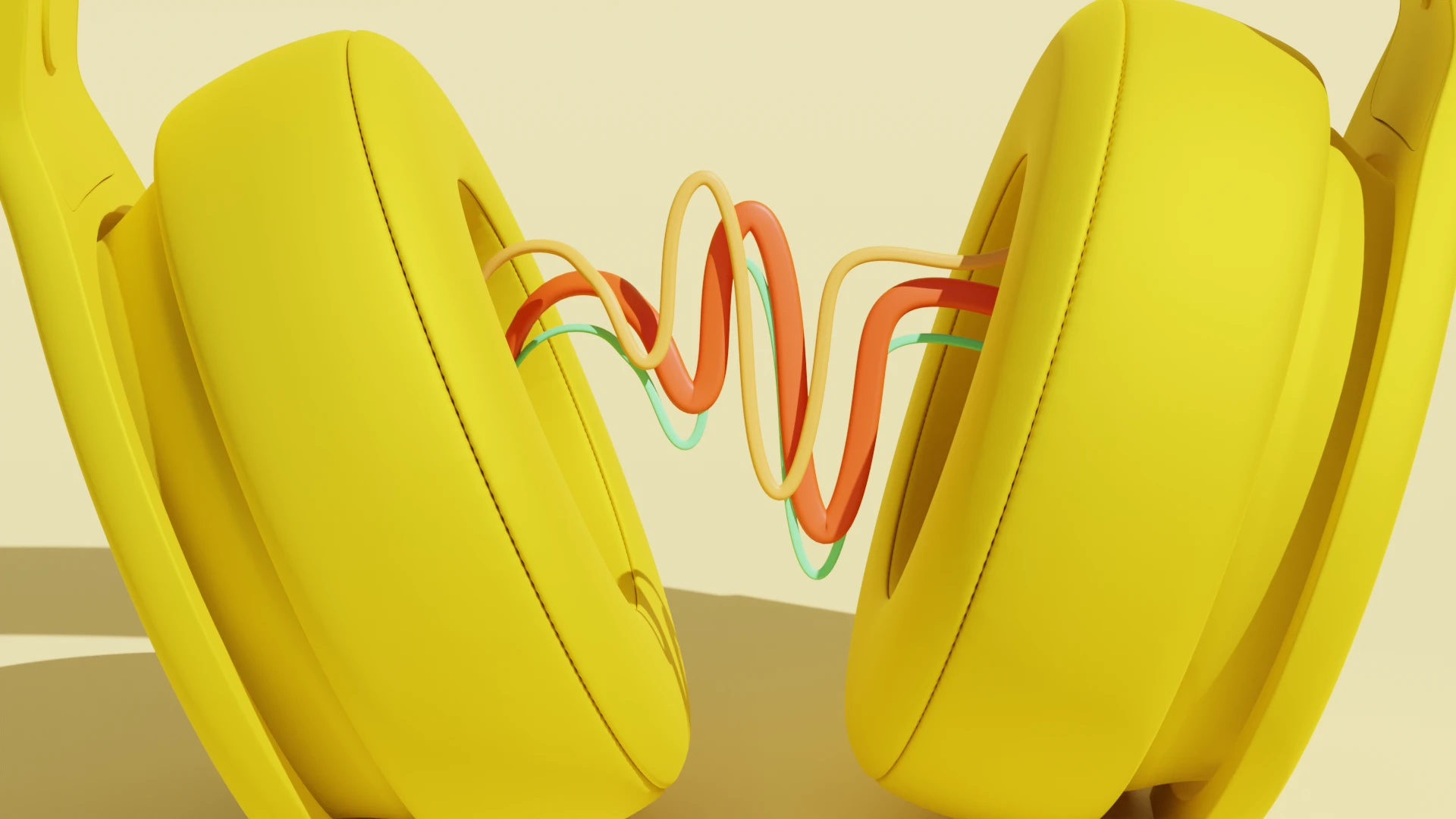What type of content do you primarily create?




Nobody wants to slog through an interview that sounds like it was recorded in a wind tunnel. If your audio’s a muddy mess, chances are your listeners won’t last long.
This is where a Digital Audio Workstation (DAW) can help.
What is a digital audio workstation (DAW)?
A DAW, or Digital Audio Workstation, is a software application that acts as an all-in-one creation suite for audio that handles recording, editing, mixing, and producing audio files. A DAW helps podcasters create professional-sounding audio by editing the content, polishing up the sound quality, and adding effects.
Why do podcasters need a DAW?
A DAW gives you total control over your podcast’s sound. You can cut lulls, remove filler words, reduce background noise, and deliver a listening experience people actually stick around for.
In short, using the right DAW for a podcast can:
- Make your podcast sound crisp and consistent
- Let you team up with co-hosts or editors effortlessly
- Cut down on busywork, so you can actually focus on the fun stuff
The best part? There are quite a few free options out there in the world of DAWs for podcasters.
13 best free DAWs for podcasters
- Descript
- GarageBand
- Audacity
- Reaper
- Waveform Free
- Cakewalk by BandLab
- LUNA
- Pro Tools – Intro
- Ardour
- SoundBridge
- Podium Free
- Zrythm Free
- Magix Music Maker
Finding the right DAW for your podcast might seem daunting. There are so many DAWs out there—what is the right one for your podcast?
To help you weigh and understand the features you need without getting lost in the technical details, we’ve prepared a list of the best free DAWs for podcasters.
1. Descript: a free, AI-powered DAW designed for podcasters
 |
Descript is a simple, powerful podcast editing software that allows podcasters to record high-quality audio and 4K video from anywhere with a built-in remote recording studio. It also helps you spin your recordings into polished video or social clips in minutes, so you can share standout moments with your audience in all the right places. The best part? Descript is as simple as a Word doc, but as powerful as a DAW. It automatically transcribes your files in seconds, so you can quickly make audio edits directly from the transcript or dive into a traditional multitrack timeline editor. Descript offers a free plan. Paid plans start at $12 per month.
- Pros:
- Automatically transcribe files in seconds, so you can visualize the dialogue and make audio edits like you're editing a doc
- Create an AI clone of your voice, then change or add audio of yourself speaking by typing what you want to hear
- Remove filler words with a single click
- Everything you need for your full podcast editing workflow
- Collaboration features allow you to share files, add comments, and work on the same project simultaneously
- Mac, Windows, and web-based versions available
- Cons:
- May not offer some of the advanced features found in professional-grade software
- Available on: Mac and Windows
2. GarageBand: best for beginners
 |
GarageBand is a free, entry-level DAW installed on every Apple Mac. It’s easy to learn and use with an intuitive, modern design. GarageBand is light on features, but it's free, as part of the standard Apple suite of software programs, and it offers a “podcast” preset, which makes it a good option for beginners.
- Pros:
- User-friendly interface
- Straightforward and intuitive dashboard
- Offers multi-track recording and virtual effects
- Cons:
- No mixing console view
- Available on: Mac only
3. Audacity: open-source software
 |
Audacity is a free and open-source digital audio editor and recording application software for Windows, MacOS, and Linux. Audacity is only available for desktop computers or laptops—there's no mobile version. Since Audacity is an open-source application, there’s a wider community working on it, and many third-party plugins have been developed for the platform.
- Pros:
- Supports a wide range of audio formats
- Customizable with unlimited audio tracks
- Audio recording, a multi-stack setup, and the ability to edit audio levels and add sound effects
- Cons:
- Lacks some professional editing features
- No MIDI compatibility
- Not suitable for advanced audio production
- Available on: Windows, MacOS, and Linux
4. REAPER: highly customizable platform
 |
REAPER is a complete digital audio production application for computers, offering a full multitrack audio and MIDI recording, editing, processing, mixing, and mastering toolset. Reaper is technically not free, but it offers a 60-day free trial with full functionality. After the trial, there are two types of licenses—a discounted license for $60 and a commercial license for $225. You can buy the discounted license if REAPER is for personal use or if you are an individual or business using REAPER commercially (and yearly gross revenue does not exceed $20,000.)
- Pros:
- Highly customizable and affordable DAW
- Powerful audio and MIDI routing with multichannel support throughout
- Hundreds of studio-quality effects for processing audio and MIDI and built-in tools for creating new effects
- Efficient and fast to load
- Cons:
- Steep learning curve
- Unintuitive interface
- Available on: Microsoft Windows (XP and newer), macOS (10.5 and newer), and Linux
5. Waveform Free: unlimited free DAW
 |
Waveform Free offers simplistic multitrack recording and powerful dialogue editing capabilities, which make it a great choice for podcasting. The new browser makes locating and auditioning jingles, FX, or backing tracks simple and easy. Aside from the free version, users can upgrade to Waveform Pro starting at $99.
- Pros:
- Unlimited audio, MIDI, and auxiliary tracks
- Flexible export options
- Cross-platform friendly (OS X, Windows, and Linux)
- Supports VST, VST 3, and AU plugin formats
- Cons:
- Lacks some features only available in the Pro version, like silence removal, real-time audio editing, colored waveforms, extracting audio from video, etc.
- Available on: Mac, Windows, and Linux
6. Cakewalk by BandLab: for Windows users
 |
Cakewalk by BandLab offers advanced technology, effortless workflow, and an intuitive interface. This DAW offers powerful capabilities that allow users to create, edit, mix, and master audio. Cakewalk by BandLab provides a comprehensive set of tools and features, making it a suitable choice for both beginners and professionals.
- Pros:
- Fully customizable interface
- Unlimited audio, MIDI, instrument, loop, and auxiliary tracks in every project
- Compatibility with touch devices adds an analog feel and workflow-enhancing efficiency
- Offers abilities to integrate mobile apps into the workflow
- Built-in mastering tools
- Cons:
- Limitations around the operating system support
- Available on: Windows only
7. LUNA: emulate classic studio hardware
 |
LUNA is a next-generation DAW from Universal Audio that makes it easy to record, edit, and mix. LUNA is available free to all Mac users. There’s a fairly simple learning curve, and LUNA also includes hours of tutorials to help you learn faster. The company also offers the LUNA Pro Bundle for $199 if you want to extend its functionality.
- Pros:
- Available to Mac users for free with no hardware purchase required
- Built-in set of features that emulate the sound of classic studio hardware
- Unlimited track count
- Cons:
- Limitations around the operating system support
- Available on: Mac only
8. Pro Tools – Intro: best for podcasters with lofty goals
 |
Pro Tools Intro is the free version of the popular Pro Tools DAW, which is standard in the audio industry. Pro Tools Intro gives you the essential audio and MIDI tools you need, plus 36 effects and instrument plugins. Pro Tools can help you with your podcast workflow from non-linear clip launching to world-class editing and mixing. Along with the free version, Pro Tools offers three other tiers—Pro Tools Artist, Pro Tools Studio, and Pro Tools Ultimate—starting at $9.99/month.
- Pros:
- Preset specifically for podcasts
- Access to a huge selection of audio editing tools
- You can choose from four editing modes: Shuffle, Slip, Spot, and Grid. Shuffle mode is ideal for podcast editing
- Good introduction to industry-standard software
- Cons:
- Limit of eight audio tracks, eight instrument tracks, and eight MIDI tracks
- Steep learning curve
- Available on: macOS Sonoma
9. Ardour: powerful capabilities
 |
Ardour is an open-source, collaborative effort of a worldwide team including musicians, programmers, and professional recording engineers. Ardour's source list makes organizing and navigating even large amounts of clips and tape easy. Multiple ripple modes make editing easy, whether a simple two-mic episode or tape-heavy features.
But as an open-source DAW designed primarily for music production and sound engineering, it may not have some specific tools or workflows optimized for podcasting out of the box, like built-in noise reduction presets or distribution integration.
- Pros:
- Record, edit, mix, and master audio and MIDI projects
- Unlimited number of tracks and busses
- Non-linear editing
- Non-destructive recording
- The integrated freesound.org search provides easy access to thousands of clips and jingles
- Cons:
- Steep learning curve
- Not necessarily designed for podcasting
- Available on: Linux, Mac, FreeBSD, and Windows
10. SoundBridge: simple DAW for easy use
 |
SoundBridge is a cross-platform digital audio workstation for Mac and Windows that redefines simplicity and ease of use. The intuitive features and user-friendly interface empower both beginners and seasoned professionals to create high-quality podcasts. Besides the free version, there are two paid options—the Everything Bundle starting at $9.99/month and Lifetime License for $179.99.
- Pros:
- Intuitive interface
- Easy navigation
- Lifetime exports of audio assets
- Third-party plugins
- Cons:
- 10-track limit
- Limited features
- Available on: Mac and Windows
11. Podium Free: straightforward layout
 |
Podium Free is a freeware edition of Podium by Zynewave. It's fully functional with only a few feature limitations. With Podium Free, users can compose, mix, and master their audio projects with a wide range of features and tools. The paid Podium license starts from $50 a year.
- Pros:
- Modern production host that integrates audio recording, VST plugins, and external MIDI and audio gear
- Unlimited tracks in the free version
- Intuitive design full of editing options
- Cons:
- MIDI interface setup is limited to one input and one output
- 64-bit mixer engine option is disabled
- Plugin multiprocessing is disabled
- Available on: Windows only
12. Zrythm Free: intuitive open-source DAW
 |
Zrythm is a highly automated and intuitive digital audio workstation. What makes this DAW stand out is its intuitive and very easy-to-use user interface. Zrythm also has a localized UI that allows users to use it in their preferred language.
- Pros:
- Intuitive editing
- Limitless automation
- Mixing capabilities
- Support for every major plugin format
- Automatic project backups
- Cons:
- Zrythm is open-source, which may lead to a lack of support
- Available on: Windows, Mac & Linux (beta)
13. Magix Music Maker: DAW for absolute beginners
 |
Music Maker Free is completely free and offers everything you need to record and edit a podcast. It's ideal for beginners, thanks to its user-friendly interface, intuitive tools, and in-app tutorials. There's also a paid version—Music Maker Premium, which is fee-based and offers you an infinite number of tracks and many creative tools for professional-sounding productions.
- Pros:
- Intuitive editing features
- Multiple tracks and a virtual mixer to combine different recordings
- Collection of professional effects to increase speech clarity
- Cons:
- Music Maker is software for music production, but can also be used for podcast audio editing
- Available on: Windows only
Improve your podcast audio with Descript
Whether you’re new to podcast production or a pro looking for a more intuitive DAW, Descript’s AI-powered features can help transform your raw recordings into shareable, polished episodes. It even surfaces attention-grabbing moments for social clips—so you can extend your reach across platforms without extra hassle.
Discover why some of the world's top podcasts—like Planet Money, The Take, and Conan O'Brien Needs a Friend—use Descript.
Take a tour of Descript today.
FAQ
Do I need a DAW for podcasting?
You can record and publish a podcast without a DAW if you plan to leave your audio unedited. However, most creators use a DAW or editing software to remove mistakes, improve sound quality, and add music or effects. If you want an all-in-one editor that’s simple to use, consider Descript to record, edit, and publish your shows in one place.
How do I choose a DAW for podcasting?
Focus on software that matches your workflow, offers the editing features you need, and fits your budget. Look for simple editing tools, easy collaboration features, and reliable publishing options. Descript, for example, provides AI transcripts and text-based editing, which can be helpful if you want to speed up post-production.
Is there a completely free DAW?
Some recording and editing tools have free plans, though the available features may vary. For example, Descript provides a free plan that includes recording, editing, and AI transcription for a set number of minutes each month. This option covers many basic podcasting needs at no cost.
What DAW should beginners use?
Beginners often need tools that simplify audio cleanup and editing. Descript offers a user-friendly interface, text-based editing, and automated features like filler-word removal. If you want to get started quickly and focus on content instead of technical setup, a beginner-friendly DAW like Descript can help you record and publish without much hassle.
Does Windows have a free DAW?
Yes. Certain cross-platform options run on Windows and offer free service tiers that include essential editing features. For instance, Descript runs on Windows and has a free plan that covers recording, editing, and AI-assisted tools. This lets you explore and produce your podcast without an upfront cost.





























%201.svg)




















%20(1).JPG)

